WSU Report: Analyzing Procurement Methods in Construction
VerifiedAdded on 2022/10/18
|17
|3124
|8
Report
AI Summary
This report provides an analysis of different procurement methods used in the construction industry, focusing on both conventional (traditional) and modern approaches (design-build and management procurement). It details the characteristics, advantages, and disadvantages of each method, considering the impact on various stakeholders including clients, consultants, builders, subcontractors, and end-users. The report includes a comparison chart to highlight the key differences between the methods and offers recommendations on which procurement methods are best suited for different types of construction projects, emphasizing ethical considerations for advising potential owners/developers. The report concludes with a summary of the findings and a disclaimer, with references conforming to the WSU Harvard system.
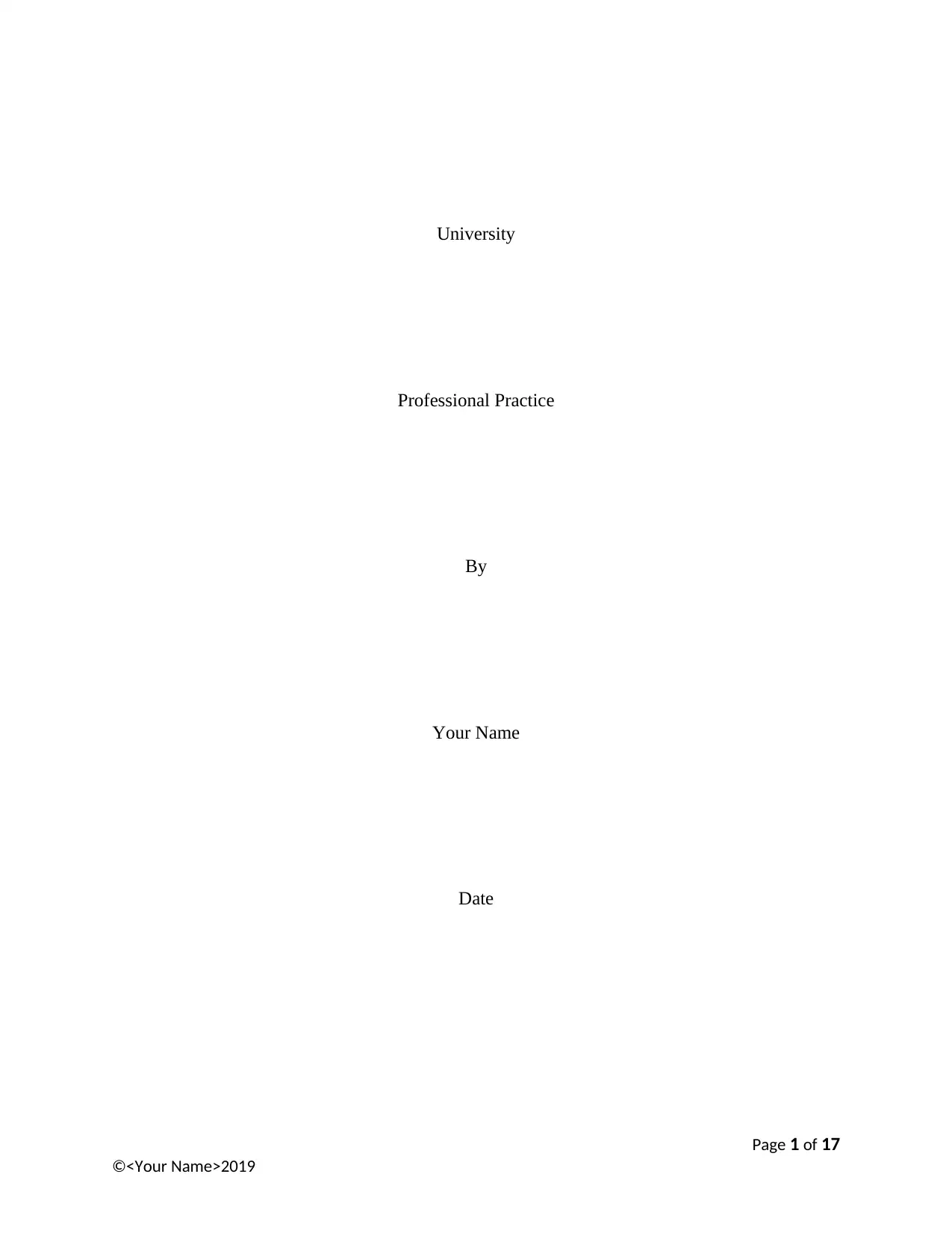
University
Professional Practice
By
Your Name
Date
Page 1 of 17
©<Your Name>2019
Professional Practice
By
Your Name
Date
Page 1 of 17
©<Your Name>2019
Paraphrase This Document
Need a fresh take? Get an instant paraphrase of this document with our AI Paraphraser
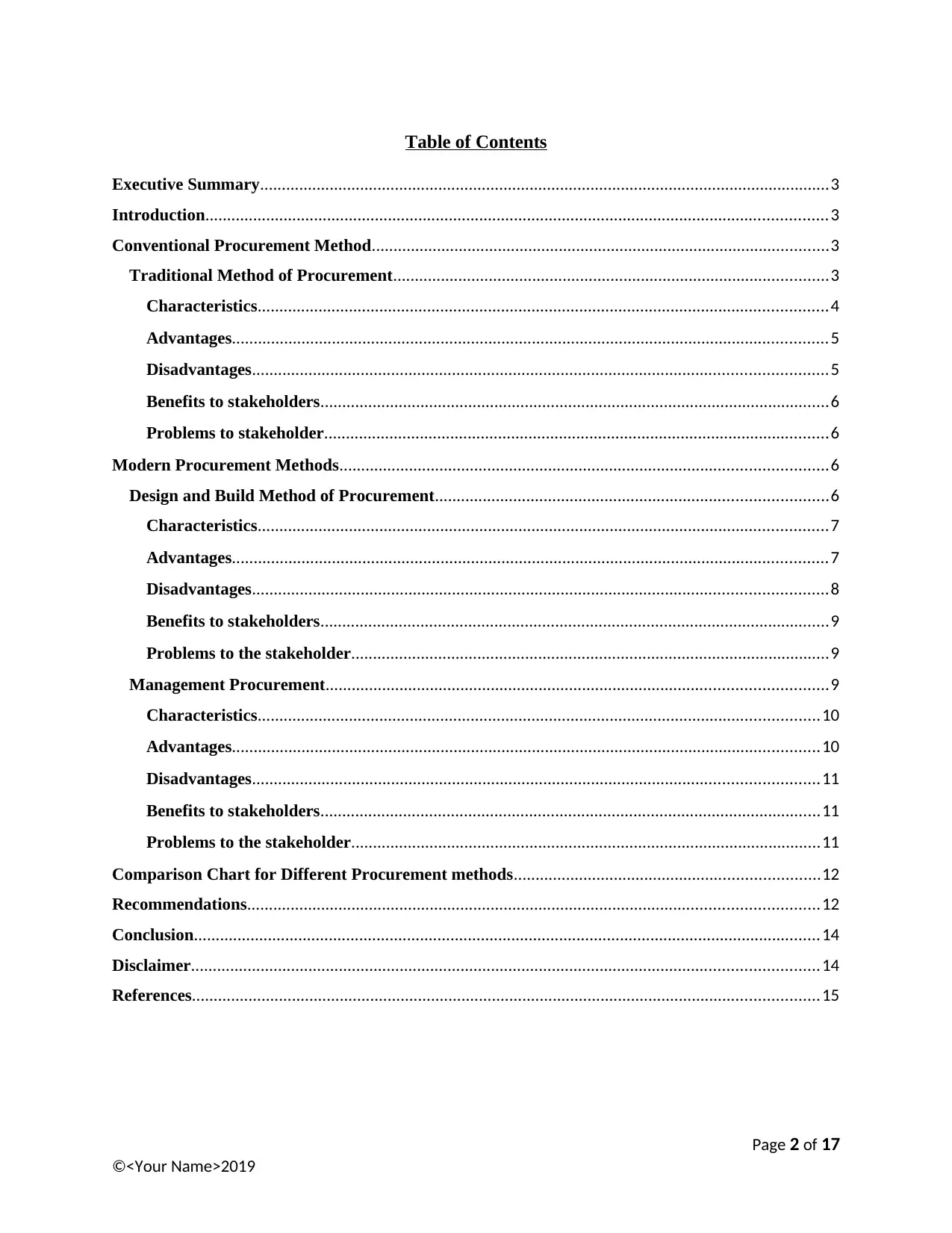
Table of Contents
Executive Summary...................................................................................................................................3
Introduction...............................................................................................................................................3
Conventional Procurement Method.........................................................................................................3
Traditional Method of Procurement....................................................................................................3
Characteristics...................................................................................................................................4
Advantages.........................................................................................................................................5
Disadvantages....................................................................................................................................5
Benefits to stakeholders.....................................................................................................................6
Problems to stakeholder....................................................................................................................6
Modern Procurement Methods................................................................................................................6
Design and Build Method of Procurement..........................................................................................6
Characteristics...................................................................................................................................7
Advantages.........................................................................................................................................7
Disadvantages....................................................................................................................................8
Benefits to stakeholders.....................................................................................................................9
Problems to the stakeholder..............................................................................................................9
Management Procurement...................................................................................................................9
Characteristics.................................................................................................................................10
Advantages.......................................................................................................................................10
Disadvantages..................................................................................................................................11
Benefits to stakeholders...................................................................................................................11
Problems to the stakeholder............................................................................................................11
Comparison Chart for Different Procurement methods......................................................................12
Recommendations...................................................................................................................................12
Conclusion................................................................................................................................................14
Disclaimer................................................................................................................................................14
References................................................................................................................................................15
Page 2 of 17
©<Your Name>2019
Executive Summary...................................................................................................................................3
Introduction...............................................................................................................................................3
Conventional Procurement Method.........................................................................................................3
Traditional Method of Procurement....................................................................................................3
Characteristics...................................................................................................................................4
Advantages.........................................................................................................................................5
Disadvantages....................................................................................................................................5
Benefits to stakeholders.....................................................................................................................6
Problems to stakeholder....................................................................................................................6
Modern Procurement Methods................................................................................................................6
Design and Build Method of Procurement..........................................................................................6
Characteristics...................................................................................................................................7
Advantages.........................................................................................................................................7
Disadvantages....................................................................................................................................8
Benefits to stakeholders.....................................................................................................................9
Problems to the stakeholder..............................................................................................................9
Management Procurement...................................................................................................................9
Characteristics.................................................................................................................................10
Advantages.......................................................................................................................................10
Disadvantages..................................................................................................................................11
Benefits to stakeholders...................................................................................................................11
Problems to the stakeholder............................................................................................................11
Comparison Chart for Different Procurement methods......................................................................12
Recommendations...................................................................................................................................12
Conclusion................................................................................................................................................14
Disclaimer................................................................................................................................................14
References................................................................................................................................................15
Page 2 of 17
©<Your Name>2019

Procurement Methods in Construction
Executive Summary
The construction industry utilizes different methods of procurement to ensure efficient planning,
budgeting and execution of a project. Conventional and Modern procurements are used. The
commonly used conventional method is the traditional method while the commonly used modern
methods are the design-build method and the management method. Any method involved in
procurement has its own characteristic, advantages, and disadvantages. Also, different
procurement methods impact the stakeholders in the construction industry differently.
Nevertheless, the choice of a procurement methods depends entirely on the choice of the client
and the prevailing conditions at the time of project actualization.
Introduction
Procurement is a very critical process in any construction industry. It is the determinant of how
smoothly and fast a project will be actualized (Suresh, Chan, and Mubarak, 2018). Moreover, a
procurement process determines the quality of the work done in construction and whether or not
it will meet the client’s expectations (Anthony, 2016). The focus of this paper is to present the
conventional and modern procurements methods used in the construction industry. It looks into
the characteristics, merits, and demerits of the procurement methods overly and to the
stakeholders in the construction industry.
Conventional Procurement Method
Traditional Method of Procurement
The traditional method of procurement is widely used in construction projects. In this method,
the client employs the services of an architect, a contractor and a consultant distinctly. The
Page 3 of 17
©<Your Name>2019
Executive Summary
The construction industry utilizes different methods of procurement to ensure efficient planning,
budgeting and execution of a project. Conventional and Modern procurements are used. The
commonly used conventional method is the traditional method while the commonly used modern
methods are the design-build method and the management method. Any method involved in
procurement has its own characteristic, advantages, and disadvantages. Also, different
procurement methods impact the stakeholders in the construction industry differently.
Nevertheless, the choice of a procurement methods depends entirely on the choice of the client
and the prevailing conditions at the time of project actualization.
Introduction
Procurement is a very critical process in any construction industry. It is the determinant of how
smoothly and fast a project will be actualized (Suresh, Chan, and Mubarak, 2018). Moreover, a
procurement process determines the quality of the work done in construction and whether or not
it will meet the client’s expectations (Anthony, 2016). The focus of this paper is to present the
conventional and modern procurements methods used in the construction industry. It looks into
the characteristics, merits, and demerits of the procurement methods overly and to the
stakeholders in the construction industry.
Conventional Procurement Method
Traditional Method of Procurement
The traditional method of procurement is widely used in construction projects. In this method,
the client employs the services of an architect, a contractor and a consultant distinctly. The
Page 3 of 17
©<Your Name>2019
⊘ This is a preview!⊘
Do you want full access?
Subscribe today to unlock all pages.

Trusted by 1+ million students worldwide
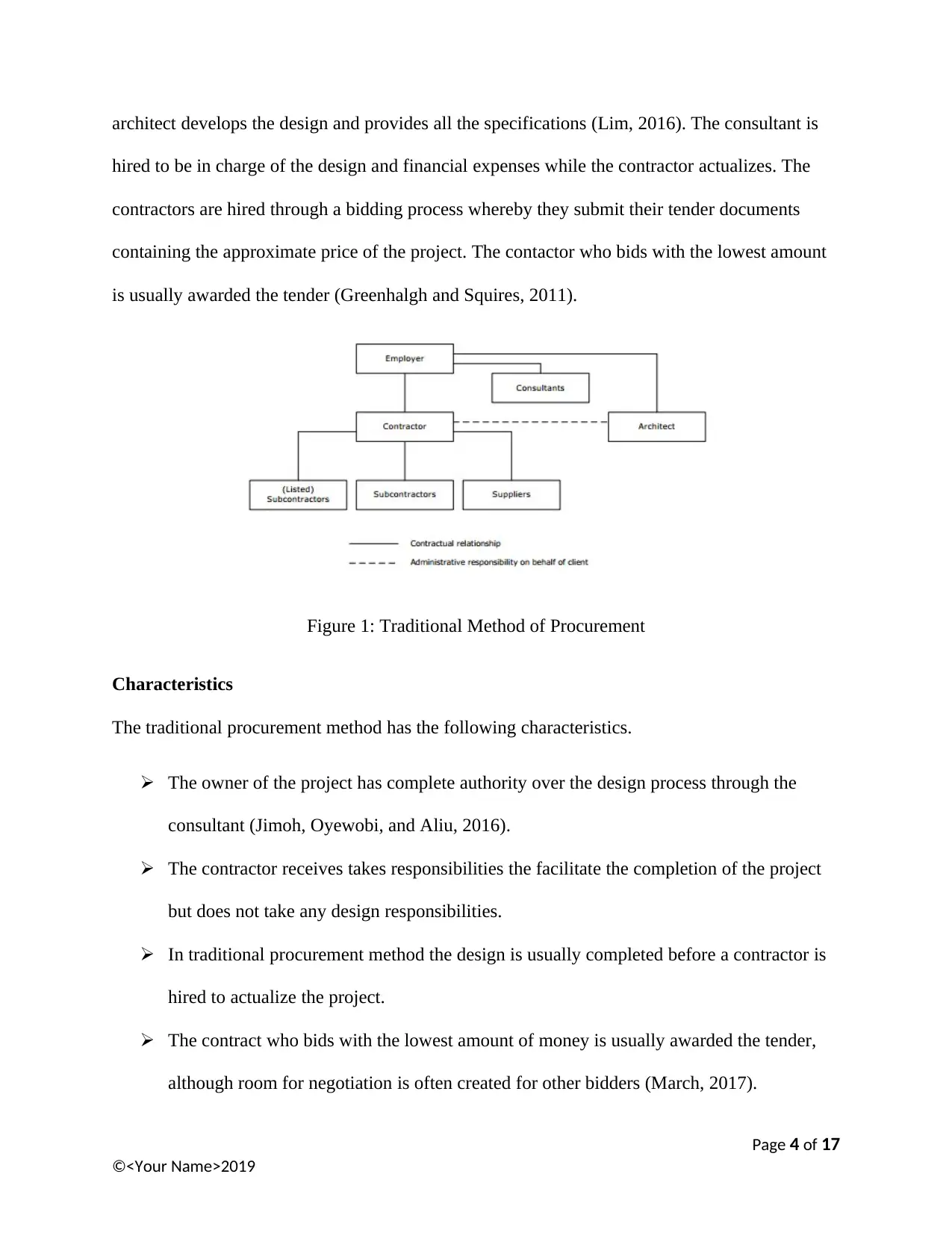
architect develops the design and provides all the specifications (Lim, 2016). The consultant is
hired to be in charge of the design and financial expenses while the contractor actualizes. The
contractors are hired through a bidding process whereby they submit their tender documents
containing the approximate price of the project. The contactor who bids with the lowest amount
is usually awarded the tender (Greenhalgh and Squires, 2011).
Figure 1: Traditional Method of Procurement
Characteristics
The traditional procurement method has the following characteristics.
The owner of the project has complete authority over the design process through the
consultant (Jimoh, Oyewobi, and Aliu, 2016).
The contractor receives takes responsibilities the facilitate the completion of the project
but does not take any design responsibilities.
In traditional procurement method the design is usually completed before a contractor is
hired to actualize the project.
The contract who bids with the lowest amount of money is usually awarded the tender,
although room for negotiation is often created for other bidders (March, 2017).
Page 4 of 17
©<Your Name>2019
hired to be in charge of the design and financial expenses while the contractor actualizes. The
contractors are hired through a bidding process whereby they submit their tender documents
containing the approximate price of the project. The contactor who bids with the lowest amount
is usually awarded the tender (Greenhalgh and Squires, 2011).
Figure 1: Traditional Method of Procurement
Characteristics
The traditional procurement method has the following characteristics.
The owner of the project has complete authority over the design process through the
consultant (Jimoh, Oyewobi, and Aliu, 2016).
The contractor receives takes responsibilities the facilitate the completion of the project
but does not take any design responsibilities.
In traditional procurement method the design is usually completed before a contractor is
hired to actualize the project.
The contract who bids with the lowest amount of money is usually awarded the tender,
although room for negotiation is often created for other bidders (March, 2017).
Page 4 of 17
©<Your Name>2019
Paraphrase This Document
Need a fresh take? Get an instant paraphrase of this document with our AI Paraphraser
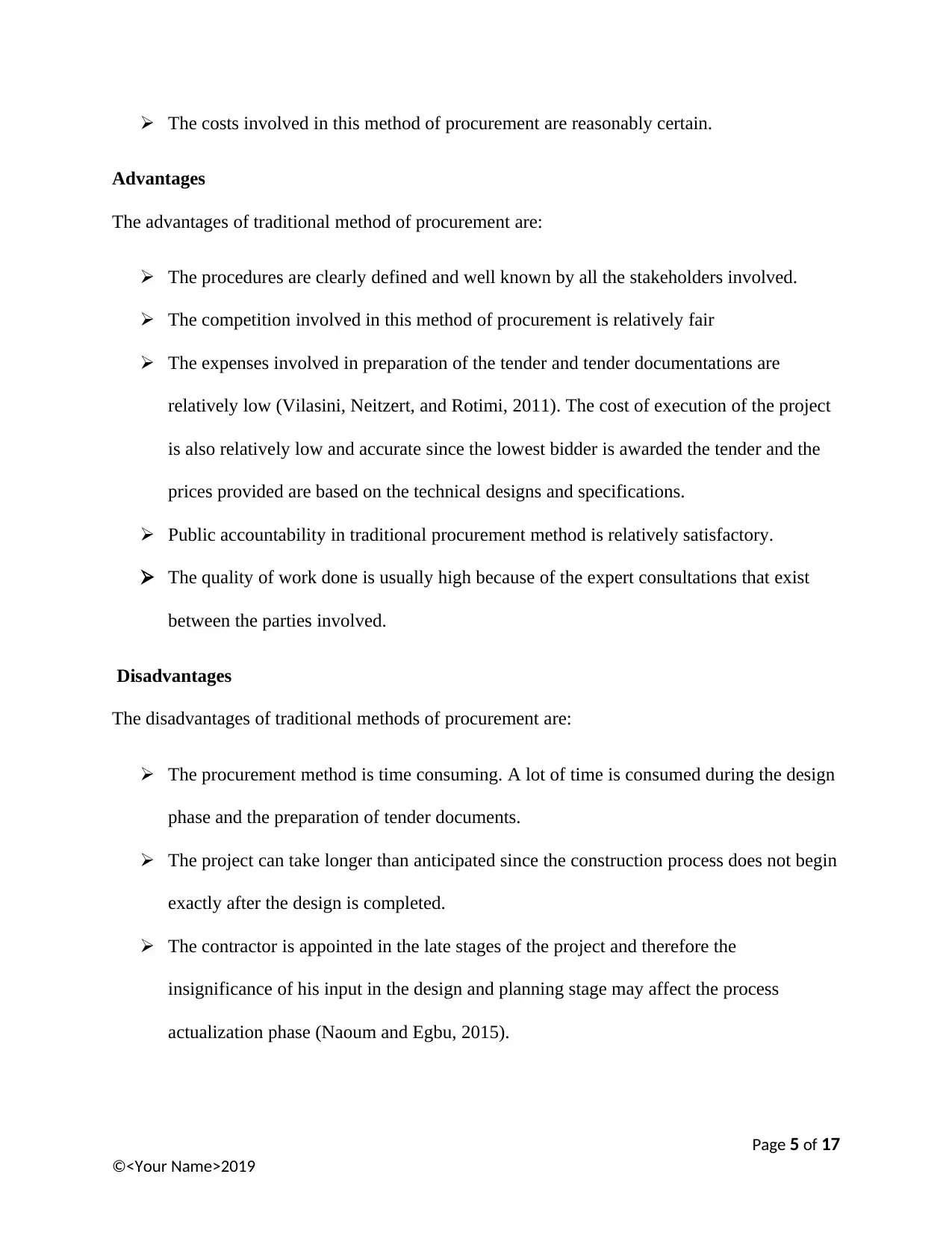
The costs involved in this method of procurement are reasonably certain.
Advantages
The advantages of traditional method of procurement are:
The procedures are clearly defined and well known by all the stakeholders involved.
The competition involved in this method of procurement is relatively fair
The expenses involved in preparation of the tender and tender documentations are
relatively low (Vilasini, Neitzert, and Rotimi, 2011). The cost of execution of the project
is also relatively low and accurate since the lowest bidder is awarded the tender and the
prices provided are based on the technical designs and specifications.
Public accountability in traditional procurement method is relatively satisfactory.
The quality of work done is usually high because of the expert consultations that exist
between the parties involved.
Disadvantages
The disadvantages of traditional methods of procurement are:
The procurement method is time consuming. A lot of time is consumed during the design
phase and the preparation of tender documents.
The project can take longer than anticipated since the construction process does not begin
exactly after the design is completed.
The contractor is appointed in the late stages of the project and therefore the
insignificance of his input in the design and planning stage may affect the process
actualization phase (Naoum and Egbu, 2015).
Page 5 of 17
©<Your Name>2019
Advantages
The advantages of traditional method of procurement are:
The procedures are clearly defined and well known by all the stakeholders involved.
The competition involved in this method of procurement is relatively fair
The expenses involved in preparation of the tender and tender documentations are
relatively low (Vilasini, Neitzert, and Rotimi, 2011). The cost of execution of the project
is also relatively low and accurate since the lowest bidder is awarded the tender and the
prices provided are based on the technical designs and specifications.
Public accountability in traditional procurement method is relatively satisfactory.
The quality of work done is usually high because of the expert consultations that exist
between the parties involved.
Disadvantages
The disadvantages of traditional methods of procurement are:
The procurement method is time consuming. A lot of time is consumed during the design
phase and the preparation of tender documents.
The project can take longer than anticipated since the construction process does not begin
exactly after the design is completed.
The contractor is appointed in the late stages of the project and therefore the
insignificance of his input in the design and planning stage may affect the process
actualization phase (Naoum and Egbu, 2015).
Page 5 of 17
©<Your Name>2019
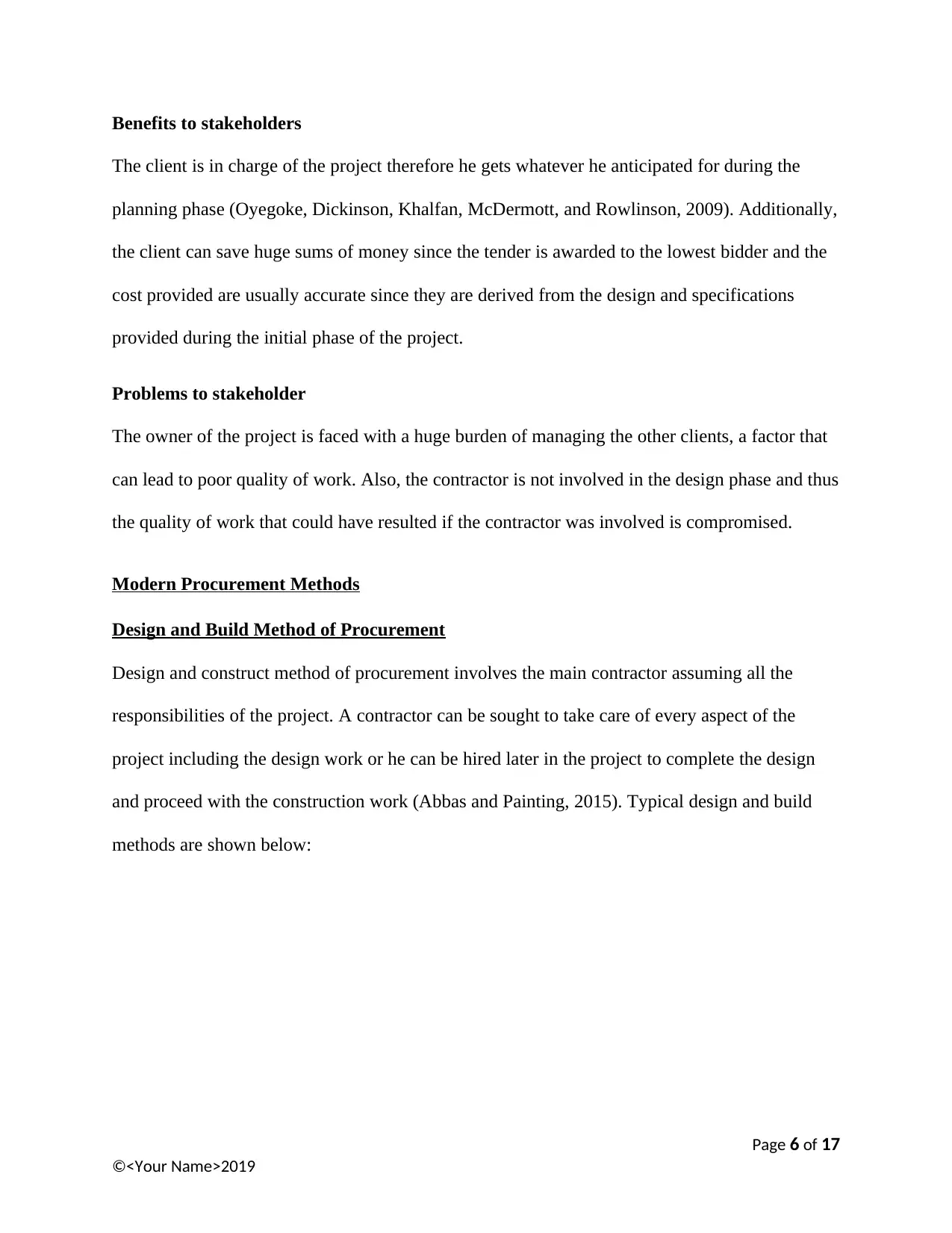
Benefits to stakeholders
The client is in charge of the project therefore he gets whatever he anticipated for during the
planning phase (Oyegoke, Dickinson, Khalfan, McDermott, and Rowlinson, 2009). Additionally,
the client can save huge sums of money since the tender is awarded to the lowest bidder and the
cost provided are usually accurate since they are derived from the design and specifications
provided during the initial phase of the project.
Problems to stakeholder
The owner of the project is faced with a huge burden of managing the other clients, a factor that
can lead to poor quality of work. Also, the contractor is not involved in the design phase and thus
the quality of work that could have resulted if the contractor was involved is compromised.
Modern Procurement Methods
Design and Build Method of Procurement
Design and construct method of procurement involves the main contractor assuming all the
responsibilities of the project. A contractor can be sought to take care of every aspect of the
project including the design work or he can be hired later in the project to complete the design
and proceed with the construction work (Abbas and Painting, 2015). Typical design and build
methods are shown below:
Page 6 of 17
©<Your Name>2019
The client is in charge of the project therefore he gets whatever he anticipated for during the
planning phase (Oyegoke, Dickinson, Khalfan, McDermott, and Rowlinson, 2009). Additionally,
the client can save huge sums of money since the tender is awarded to the lowest bidder and the
cost provided are usually accurate since they are derived from the design and specifications
provided during the initial phase of the project.
Problems to stakeholder
The owner of the project is faced with a huge burden of managing the other clients, a factor that
can lead to poor quality of work. Also, the contractor is not involved in the design phase and thus
the quality of work that could have resulted if the contractor was involved is compromised.
Modern Procurement Methods
Design and Build Method of Procurement
Design and construct method of procurement involves the main contractor assuming all the
responsibilities of the project. A contractor can be sought to take care of every aspect of the
project including the design work or he can be hired later in the project to complete the design
and proceed with the construction work (Abbas and Painting, 2015). Typical design and build
methods are shown below:
Page 6 of 17
©<Your Name>2019
⊘ This is a preview!⊘
Do you want full access?
Subscribe today to unlock all pages.

Trusted by 1+ million students worldwide
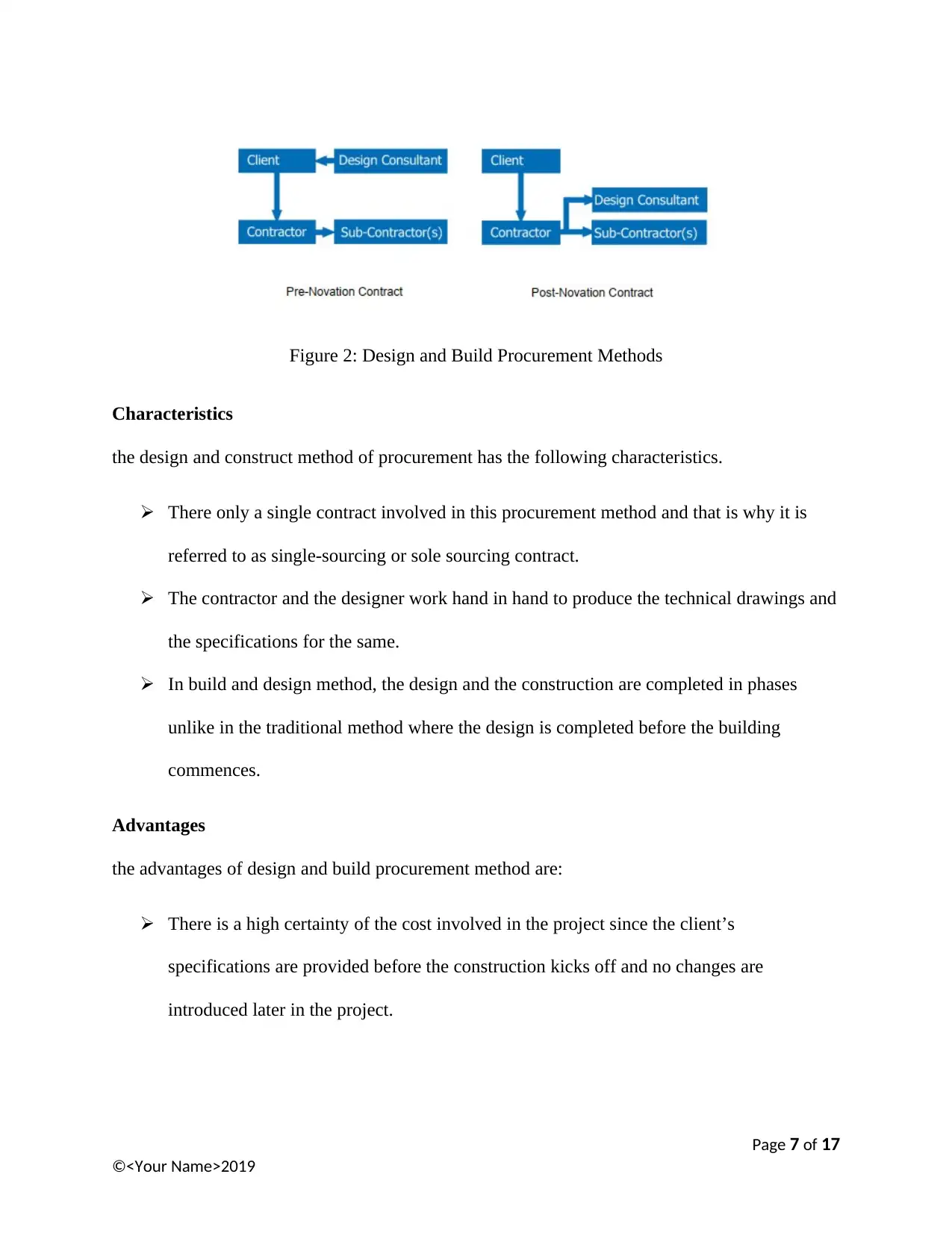
Figure 2: Design and Build Procurement Methods
Characteristics
the design and construct method of procurement has the following characteristics.
There only a single contract involved in this procurement method and that is why it is
referred to as single-sourcing or sole sourcing contract.
The contractor and the designer work hand in hand to produce the technical drawings and
the specifications for the same.
In build and design method, the design and the construction are completed in phases
unlike in the traditional method where the design is completed before the building
commences.
Advantages
the advantages of design and build procurement method are:
There is a high certainty of the cost involved in the project since the client’s
specifications are provided before the construction kicks off and no changes are
introduced later in the project.
Page 7 of 17
©<Your Name>2019
Characteristics
the design and construct method of procurement has the following characteristics.
There only a single contract involved in this procurement method and that is why it is
referred to as single-sourcing or sole sourcing contract.
The contractor and the designer work hand in hand to produce the technical drawings and
the specifications for the same.
In build and design method, the design and the construction are completed in phases
unlike in the traditional method where the design is completed before the building
commences.
Advantages
the advantages of design and build procurement method are:
There is a high certainty of the cost involved in the project since the client’s
specifications are provided before the construction kicks off and no changes are
introduced later in the project.
Page 7 of 17
©<Your Name>2019
Paraphrase This Document
Need a fresh take? Get an instant paraphrase of this document with our AI Paraphraser

Project management by the client is easy because he only deals with a single firm.
Moreover, the costs are cut down since no external consultant, designers or contractors
are hired besides the main contractor.
The contractor is involved in the design phase allowing more constructability.
The time consumed from the design phase to the completion phase is greatly reduced
since there is an overlap in the design and construction activities.
The method is flexible in that it allows easy customization of the design and the building
to match the conditions of the site.
Disadvantages
The disadvantages of the design and build method of procurement are:
The probability of the building not meet the anticipated expectations is higher.
Poor planning and budgeting at the initial stages of the project result to unnecessary
delays in project completion.
The possibility of applying integrated design is limited in design and build procurement.
Poor quality may result in circumstances where the contractor is not experienced enough
or employs the services of unskilled designers and contractors.
The exact cost of project completion can escalate beyond the cost that had been planned
and budgeted for in the initial stages of the project.
Comparison of bids is difficult since each contractor provides his own different design
and project program.
Page 8 of 17
©<Your Name>2019
Moreover, the costs are cut down since no external consultant, designers or contractors
are hired besides the main contractor.
The contractor is involved in the design phase allowing more constructability.
The time consumed from the design phase to the completion phase is greatly reduced
since there is an overlap in the design and construction activities.
The method is flexible in that it allows easy customization of the design and the building
to match the conditions of the site.
Disadvantages
The disadvantages of the design and build method of procurement are:
The probability of the building not meet the anticipated expectations is higher.
Poor planning and budgeting at the initial stages of the project result to unnecessary
delays in project completion.
The possibility of applying integrated design is limited in design and build procurement.
Poor quality may result in circumstances where the contractor is not experienced enough
or employs the services of unskilled designers and contractors.
The exact cost of project completion can escalate beyond the cost that had been planned
and budgeted for in the initial stages of the project.
Comparison of bids is difficult since each contractor provides his own different design
and project program.
Page 8 of 17
©<Your Name>2019
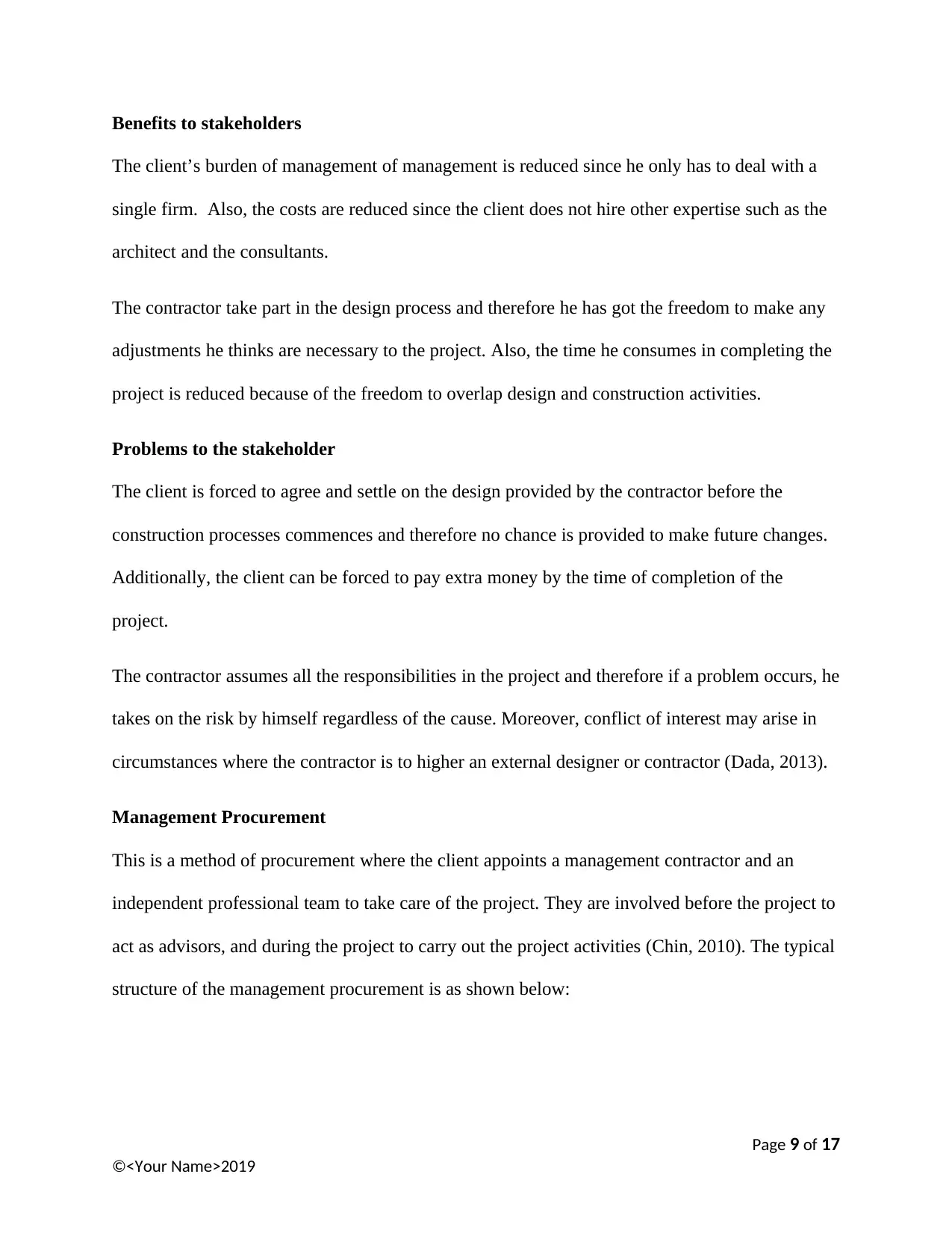
Benefits to stakeholders
The client’s burden of management of management is reduced since he only has to deal with a
single firm. Also, the costs are reduced since the client does not hire other expertise such as the
architect and the consultants.
The contractor take part in the design process and therefore he has got the freedom to make any
adjustments he thinks are necessary to the project. Also, the time he consumes in completing the
project is reduced because of the freedom to overlap design and construction activities.
Problems to the stakeholder
The client is forced to agree and settle on the design provided by the contractor before the
construction processes commences and therefore no chance is provided to make future changes.
Additionally, the client can be forced to pay extra money by the time of completion of the
project.
The contractor assumes all the responsibilities in the project and therefore if a problem occurs, he
takes on the risk by himself regardless of the cause. Moreover, conflict of interest may arise in
circumstances where the contractor is to higher an external designer or contractor (Dada, 2013).
Management Procurement
This is a method of procurement where the client appoints a management contractor and an
independent professional team to take care of the project. They are involved before the project to
act as advisors, and during the project to carry out the project activities (Chin, 2010). The typical
structure of the management procurement is as shown below:
Page 9 of 17
©<Your Name>2019
The client’s burden of management of management is reduced since he only has to deal with a
single firm. Also, the costs are reduced since the client does not hire other expertise such as the
architect and the consultants.
The contractor take part in the design process and therefore he has got the freedom to make any
adjustments he thinks are necessary to the project. Also, the time he consumes in completing the
project is reduced because of the freedom to overlap design and construction activities.
Problems to the stakeholder
The client is forced to agree and settle on the design provided by the contractor before the
construction processes commences and therefore no chance is provided to make future changes.
Additionally, the client can be forced to pay extra money by the time of completion of the
project.
The contractor assumes all the responsibilities in the project and therefore if a problem occurs, he
takes on the risk by himself regardless of the cause. Moreover, conflict of interest may arise in
circumstances where the contractor is to higher an external designer or contractor (Dada, 2013).
Management Procurement
This is a method of procurement where the client appoints a management contractor and an
independent professional team to take care of the project. They are involved before the project to
act as advisors, and during the project to carry out the project activities (Chin, 2010). The typical
structure of the management procurement is as shown below:
Page 9 of 17
©<Your Name>2019
⊘ This is a preview!⊘
Do you want full access?
Subscribe today to unlock all pages.

Trusted by 1+ million students worldwide
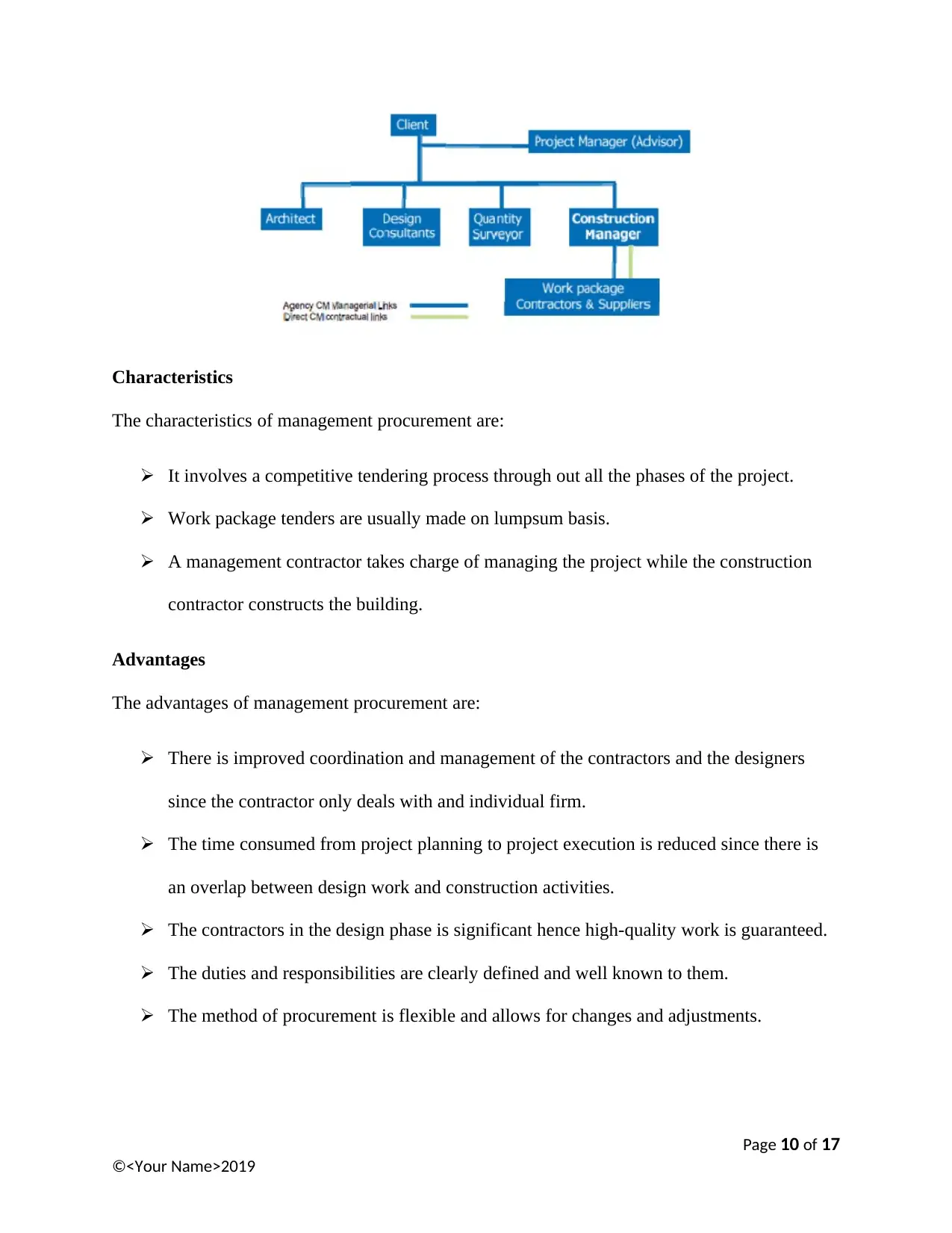
Characteristics
The characteristics of management procurement are:
It involves a competitive tendering process through out all the phases of the project.
Work package tenders are usually made on lumpsum basis.
A management contractor takes charge of managing the project while the construction
contractor constructs the building.
Advantages
The advantages of management procurement are:
There is improved coordination and management of the contractors and the designers
since the contractor only deals with and individual firm.
The time consumed from project planning to project execution is reduced since there is
an overlap between design work and construction activities.
The contractors in the design phase is significant hence high-quality work is guaranteed.
The duties and responsibilities are clearly defined and well known to them.
The method of procurement is flexible and allows for changes and adjustments.
Page 10 of 17
©<Your Name>2019
The characteristics of management procurement are:
It involves a competitive tendering process through out all the phases of the project.
Work package tenders are usually made on lumpsum basis.
A management contractor takes charge of managing the project while the construction
contractor constructs the building.
Advantages
The advantages of management procurement are:
There is improved coordination and management of the contractors and the designers
since the contractor only deals with and individual firm.
The time consumed from project planning to project execution is reduced since there is
an overlap between design work and construction activities.
The contractors in the design phase is significant hence high-quality work is guaranteed.
The duties and responsibilities are clearly defined and well known to them.
The method of procurement is flexible and allows for changes and adjustments.
Page 10 of 17
©<Your Name>2019
Paraphrase This Document
Need a fresh take? Get an instant paraphrase of this document with our AI Paraphraser
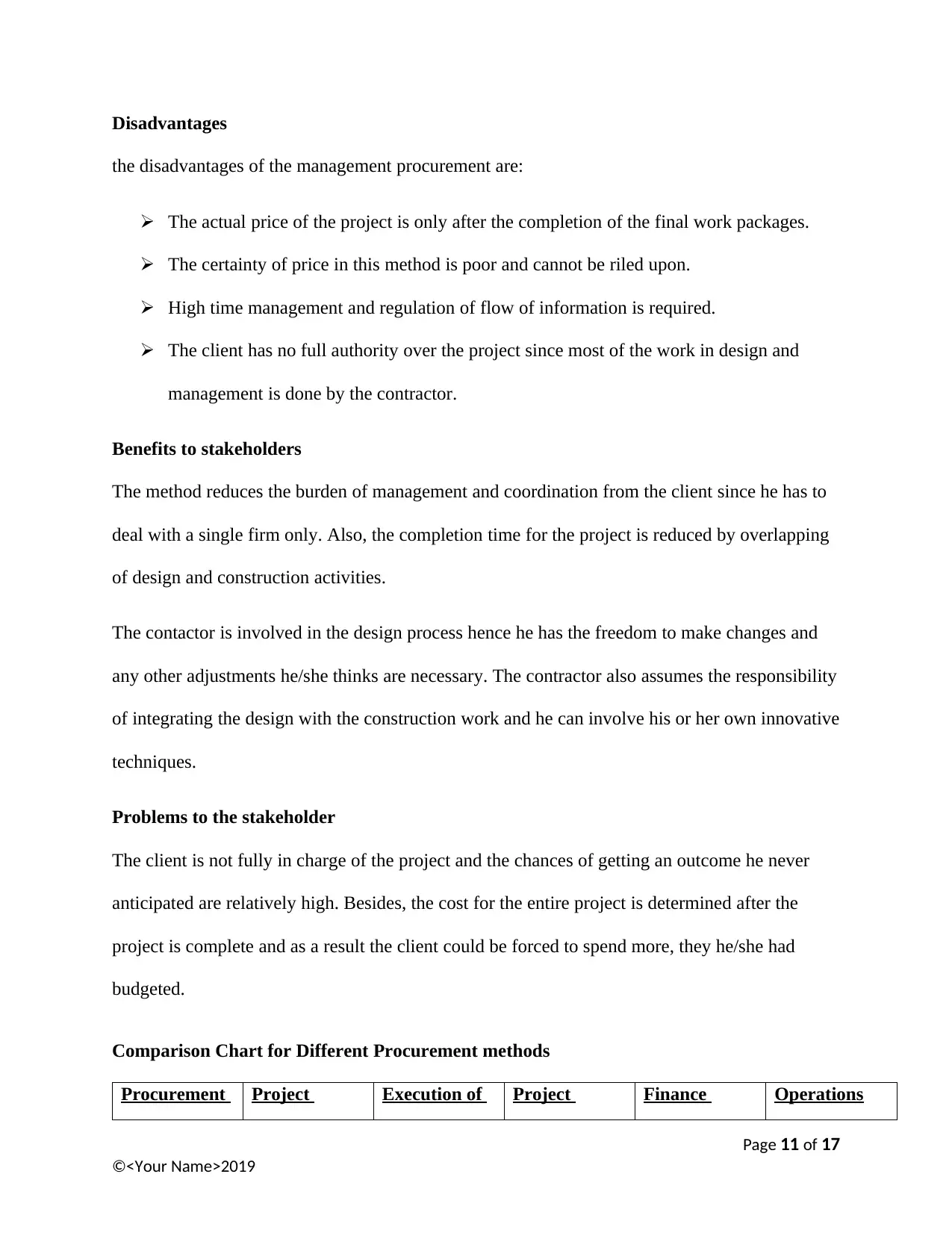
Disadvantages
the disadvantages of the management procurement are:
The actual price of the project is only after the completion of the final work packages.
The certainty of price in this method is poor and cannot be riled upon.
High time management and regulation of flow of information is required.
The client has no full authority over the project since most of the work in design and
management is done by the contractor.
Benefits to stakeholders
The method reduces the burden of management and coordination from the client since he has to
deal with a single firm only. Also, the completion time for the project is reduced by overlapping
of design and construction activities.
The contactor is involved in the design process hence he has the freedom to make changes and
any other adjustments he/she thinks are necessary. The contractor also assumes the responsibility
of integrating the design with the construction work and he can involve his or her own innovative
techniques.
Problems to the stakeholder
The client is not fully in charge of the project and the chances of getting an outcome he never
anticipated are relatively high. Besides, the cost for the entire project is determined after the
project is complete and as a result the client could be forced to spend more, they he/she had
budgeted.
Comparison Chart for Different Procurement methods
Procurement Project Execution of Project Finance Operations
Page 11 of 17
©<Your Name>2019
the disadvantages of the management procurement are:
The actual price of the project is only after the completion of the final work packages.
The certainty of price in this method is poor and cannot be riled upon.
High time management and regulation of flow of information is required.
The client has no full authority over the project since most of the work in design and
management is done by the contractor.
Benefits to stakeholders
The method reduces the burden of management and coordination from the client since he has to
deal with a single firm only. Also, the completion time for the project is reduced by overlapping
of design and construction activities.
The contactor is involved in the design process hence he has the freedom to make changes and
any other adjustments he/she thinks are necessary. The contractor also assumes the responsibility
of integrating the design with the construction work and he can involve his or her own innovative
techniques.
Problems to the stakeholder
The client is not fully in charge of the project and the chances of getting an outcome he never
anticipated are relatively high. Besides, the cost for the entire project is determined after the
project is complete and as a result the client could be forced to spend more, they he/she had
budgeted.
Comparison Chart for Different Procurement methods
Procurement Project Execution of Project Finance Operations
Page 11 of 17
©<Your Name>2019
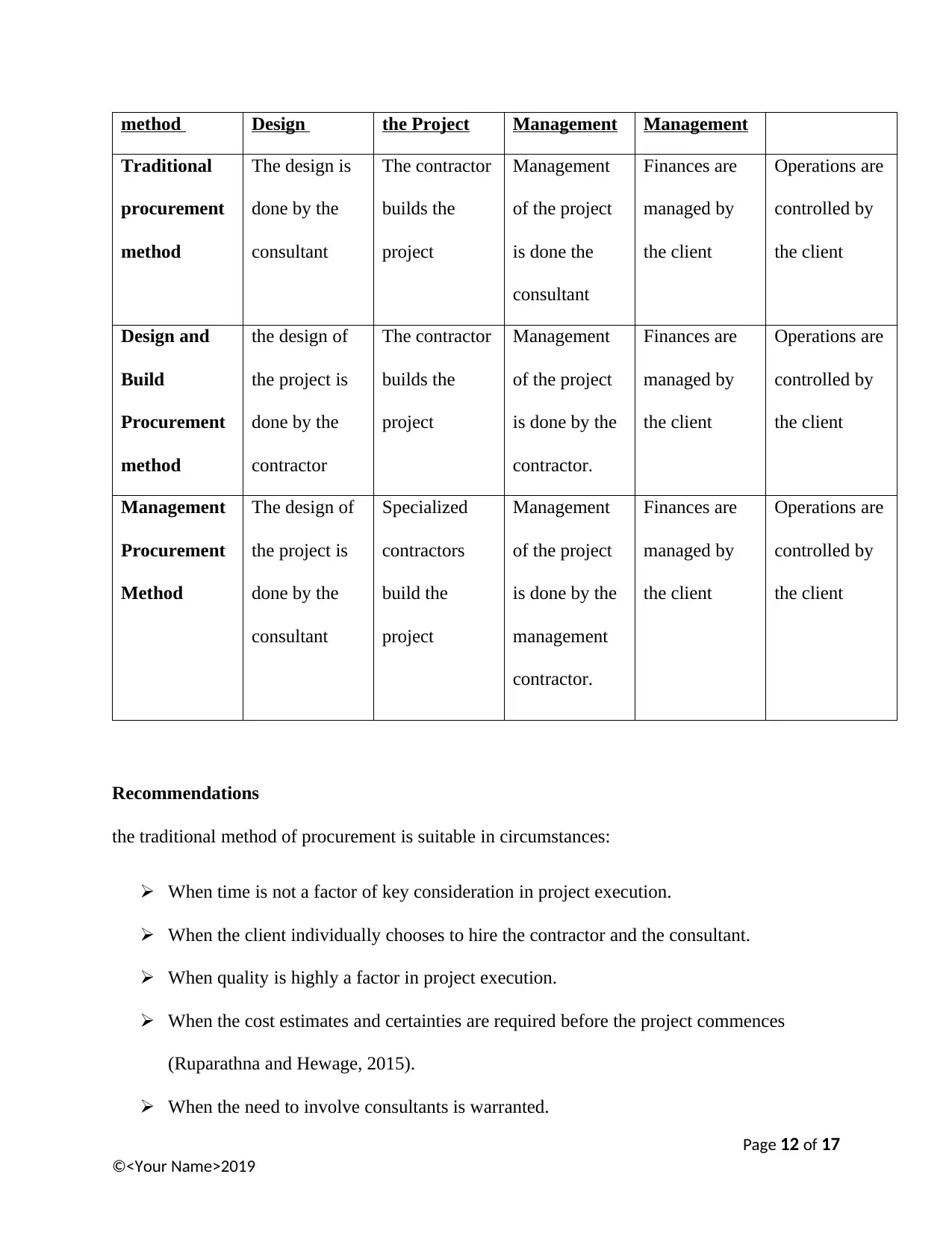
method Design the Project Management Management
Traditional
procurement
method
The design is
done by the
consultant
The contractor
builds the
project
Management
of the project
is done the
consultant
Finances are
managed by
the client
Operations are
controlled by
the client
Design and
Build
Procurement
method
the design of
the project is
done by the
contractor
The contractor
builds the
project
Management
of the project
is done by the
contractor.
Finances are
managed by
the client
Operations are
controlled by
the client
Management
Procurement
Method
The design of
the project is
done by the
consultant
Specialized
contractors
build the
project
Management
of the project
is done by the
management
contractor.
Finances are
managed by
the client
Operations are
controlled by
the client
Recommendations
the traditional method of procurement is suitable in circumstances:
When time is not a factor of key consideration in project execution.
When the client individually chooses to hire the contractor and the consultant.
When quality is highly a factor in project execution.
When the cost estimates and certainties are required before the project commences
(Ruparathna and Hewage, 2015).
When the need to involve consultants is warranted.
Page 12 of 17
©<Your Name>2019
Traditional
procurement
method
The design is
done by the
consultant
The contractor
builds the
project
Management
of the project
is done the
consultant
Finances are
managed by
the client
Operations are
controlled by
the client
Design and
Build
Procurement
method
the design of
the project is
done by the
contractor
The contractor
builds the
project
Management
of the project
is done by the
contractor.
Finances are
managed by
the client
Operations are
controlled by
the client
Management
Procurement
Method
The design of
the project is
done by the
consultant
Specialized
contractors
build the
project
Management
of the project
is done by the
management
contractor.
Finances are
managed by
the client
Operations are
controlled by
the client
Recommendations
the traditional method of procurement is suitable in circumstances:
When time is not a factor of key consideration in project execution.
When the client individually chooses to hire the contractor and the consultant.
When quality is highly a factor in project execution.
When the cost estimates and certainties are required before the project commences
(Ruparathna and Hewage, 2015).
When the need to involve consultants is warranted.
Page 12 of 17
©<Your Name>2019
⊘ This is a preview!⊘
Do you want full access?
Subscribe today to unlock all pages.

Trusted by 1+ million students worldwide
1 out of 17
Related Documents
Your All-in-One AI-Powered Toolkit for Academic Success.
+13062052269
info@desklib.com
Available 24*7 on WhatsApp / Email
![[object Object]](/_next/static/media/star-bottom.7253800d.svg)
Unlock your academic potential
Copyright © 2020–2025 A2Z Services. All Rights Reserved. Developed and managed by ZUCOL.





